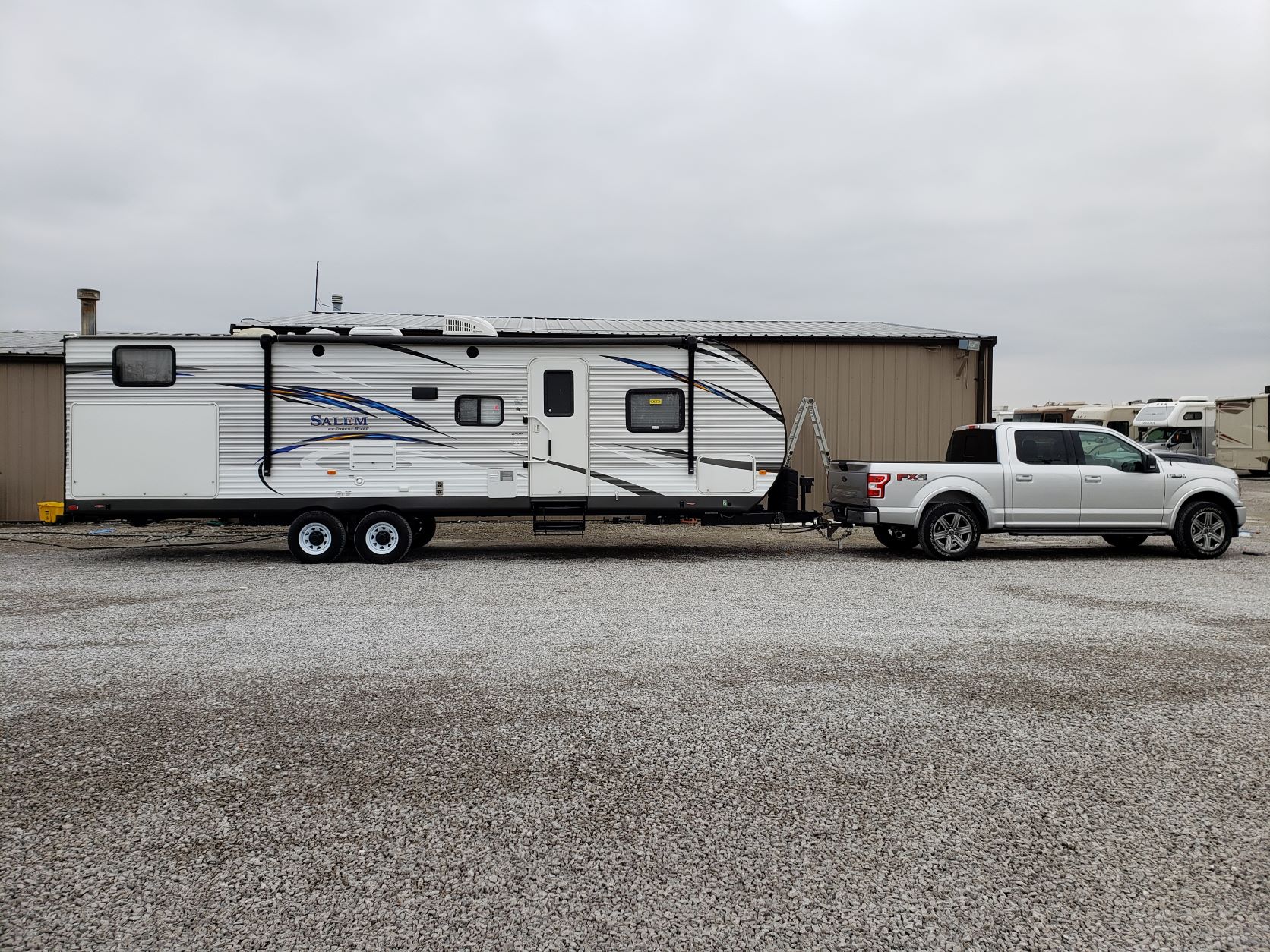At first glance, a trailer can seem simple—even rudimentary—but anyone who owns a trailer or camper can tell you that plenty of parts go unseen. Something as basic as a hitch can cause a lot of trouble if damaged or defective. ProPride hitch problems will make your trailer essentially useless.
Regarding ProPride hitches, you’ll likely have to deal with three potential problems—uncontrollable swaying, poor weight distribution, and physical damage. Each issue can be dealt with individually, but it’s always better to use precaution rather than constantly fixing problems after they happen.
In this guide, I’ll help you better understand ProPride hitches and fill you in on some of the common problems I’ve experienced with these parts. I’ll explain how to handle the issues as they come up and also share some tricks I’ve used to prevent the problems from happening again. So, before installing a ProPride hitch, let’s get into the details.
Don’t forget to check out our Recommended RV Equipment list!
What Makes ProPride Hitches Special?
ProPride hitches provide a safe and stable connection between your trailer and truck. They’re made with two hitches that are connected by a crossbar. This design is meant to distribute the weight of your trailer more evenly, which should reduce the risk of the trailer becoming unstable and swaying. ProPride hitches are also adjustable to fine-tune the tension to your specific needs.
This is a significant advantage because it lets you ensure the hitch always works correctly, even as the conditions change. For example, if you’re hauling a heavy load, you can increase the tension to account for the extra weight. Alternatively, you can reduce the tension to improve your truck’s fuel efficiency by carrying a lighter load.
Although the main advantage of ProPride hitches is that they’re designed to provide a safe and stable connection, there are a few disadvantages worth mentioning:
- ProPride hitches are more expensive than traditional hitches.
- They’re not always compatible with all trailers.
- They can be challenging to install, especially if you don’t have experience with hitches.
Keep these disadvantages in mind as you decide whether or not a ProPride hitch is the right choice for you, and be sure to check whether your truck and trailer are even compatible before making a purchase. They’re an excellent upgrade to your standard hitch, but—as with anything—they’re not perfect.
Common ProPride Hitch Problems
Now that you know more about ProPride hitches, let’s talk about some problems you might encounter. As I mentioned, you’ll have to deal with the three most common ProPride hitch problems: uncontrolled swaying, poor weight distribution, and physical damage.
Uncontrolled Swaying
One of the most frustrating problems you’ll have to deal with is uncontrollable swaying. For the most part, ProPride hitches deliver on their promise to provide a more stable connection, but over time, the parts that hold the hitch together wear down and lead to uncontrollable swaying. Usually, though, this problem is caused by loose bolts, improper tension, or incorrect installation.
If you’re having trouble with your ProPride hitch, check the bolts to ensure they’re tight. If not, tighten them until they’re snug but don’t over-tighten them, or you risk stripping the threads.
Next, check the tension of the hitch. If it’s too loose, the trailer will be able to move around too much, and this can cause the trailer to sway. The trailer will be less likely to sway if the tension is too tight, but the ride will be much rougher. You’ll need to experiment to find the sweet spot.
Finally, make sure the hitch is installed correctly. It won’t matter how tight the bolts are or how much tension you use if it’s not. Always read the manufacturer’s instructions when you’re setting up a hitch. You know precisely how to connect the trailer and truck. Alternatively, speak with a professional, or someone experienced with hooking up a hitch.
Proper Weight Distribution
Another issue you’ll have to deal with is managing proper weight distribution across the hitch. This is primarily a problem during the installation stage, but if the trailer is too heavy for the hitch or the weight is not evenly distributed, it can damage the hitch and cause your trailer to sway or drag.
If you’re having trouble with your ProPride hitch, you should first check the weight of your trailer. Some ProPride models can handle heavier trailers than others, but if it’s too heavy, the hitch won’t be able to support it properly, and the hitch may fail.
You can also try redistributing the weight of the trailer. If the trailer is too heavy in the front, try moving some of the weight you’ve loaded onto it toward the back. This will help distribute the weight more evenly and can improve stability.
If you’re not entirely sure how heavy your trailer is, you can also get it weighed at a scale to understand better how durable your ProPride hitch will need to be. Alternatively, if you’ve purchased a ProPride hitch without weighing your trailer beforehand, check the user’s manual to see how much weight it can handle.
Physical Damage
The final problem you might have to deal with is physical damage. If your trailer is ever in an accident or you jackknife the hitch into something, it can damage the connection and undermine the integrity of your hitch.
If you’re having trouble with your ProPride hitch, you should first inspect it for damage. Check all of the parts for cracks, bends, or breaks. It’s best to replace the hitch entirely if you find any damage. It’s also a good idea to inspect your trailer for damage.
Even if the hitch looks OK, the trailer might have been damaged in the accident, which can cause problems down the road.
Be sure to check the frame, axles, and wheels for any signs of damage. If you can’t find any damage, the problem may be how the hitch connects to the trailer. If the hitch is not connecting properly, it can cause the trailer to sway or drag.
The best way to fix this problem is to consult the manufacturer’s instructions or speak with a professional.
Preventing ProPride Hitch Problems
The best way to deal with ProPride hitch problems is to prevent them from happening in the first place. Although you can’t always avoid accidents, you can do a few things to minimize the risk of damage and ensure your hitch stays in good condition.
The first thing you can do is regularly inspect your hitch for damage. Even if you don’t think there’s anything wrong, it’s always better to be safe than sorry. Look closely at all the parts and ensure there are no cracks, bends, or breaks. It’s best to replace the hitch entirely if you find any damage.
Although you might be able to get away with repairing the damage, it’s not worth the risk. A new hitch is not expensive, and it’s better to be safe than sorry. You should also regularly inspect your trailer for damage. Flat tires can be awful for your hitch, as pulling unsupported weight puts undue pressure on the connection between your truck and trailer.
Another way to prevent ProPride hitch problems is to maintain the hitch properly. This includes regularly checking the bolts to ensure they’re tight and adjusting the tension as needed. It’s also good to lubricate the hitch with a silicone-based lubricant. This will help protect the metal from corrosion and make connecting and disconnecting the hitch easier.
Finally, follow the manufacturer’s instructions when installing or using the hitch. Although the hitch is designed to be easy to use, it’s always best to follow the instructions to be safe. If you’ve never installed a ProPride hitch, speak with someone with experience with these parts or take your vehicle to a professional.
The Bottom Line
ProPride hitches are an excellent choice if you want a safer and more stable connection between your trailer and truck. However, as with anything, they’re not perfect, and you might have to deal with a few problems. You’ll have to deal with the three most common ProPride hitch problems: uncontrolled swaying, poor weight distribution, and physical damage.
Fortunately, you can do a few things to prevent these problems from happening in the first place. Inspect your hitch for damage whenever needed, properly maintain it by checking and adjusting the bolts as needed, and follow the manufacturer’s instructions during the installation process.
Don’t forget to check out our Recommended RV Equipment list!
Get a FREE copy of the Go Together Go Far Travel Trailer Hookup and Disconnect Checklist when you sign up for the Go Together Go Far Newsletter!
Other RV Articles
Want to learn more about different types of RVs? Check out:
- Best Off-Road Camper Trailer Under $10,000
- Best Bunkhouse Travel Trailer Under 30 Feet
- Are Lance Travel Trailers Any Good?
- Do Rope Lights Deter Rodents?
- What Are the Best Names in the RV Industry?
- 3 Best Travel Trailers for Family of Four
- Blue Ox SwayPro Basics: Top Questions Answered
- Adding A Washer Dryer To Travel Trailer? What You Need To Know.
- Best Drone For Camping, Backpacking, and RVing: A Complete Guide to Drones for RVers
- Furniture and RVs – How To Get It Through the Door…
- How To Get Rid Of A Poop Pyramid In RV Black Tank
- Do You Know How Long To Keep Fresh Water In RV Tank Storage?
- What Is The Best Outdoor Security Camera System For Your RV?
- RV Bumper Mount Grills: 5 Best Options For Your RV Or Camper
- Best Electric Tankless Water Heater for Your RV. What You Need To Know
- Read Before You Buy! How to Find the Best Scooter for RV Camping
- 3 Best Travel Trailers for Family of Four
- Top RV Brands: What Are the Best Names in the RV Industry?
- Lance Campers: What Makes Them So Different?
- Best Bunkhouse Travel Trailer Under 30 Feet
- Best Off-Road Camper Trailer Under $10,000
- Best Weight Distribution Hitch With Sway Control For Travel Trailers in 2022
- What Are The Best Built Travel Trailers? Things To Consider.
- How Does An RV Refrigerator Work? A Quick Guide.
- Why Does My RV Carbon Monoxide Detector Keep Beeping? A Quick Guide.
- Where Is The Power Converter In My RV Or Travel Trailer
- What is the Best Generator for 50 Amp RV?
- Wireless RV Security Camera Systems: Is Solar Powered Security Without Wi-Fi An Option?
- Best Portable Air Conditioner for Camping for 2022
- How to Find the Best 3500 Watt Inverter Generator for RV Camping
- Best Propane Generator For Your RV: Read This Before You Buy!

